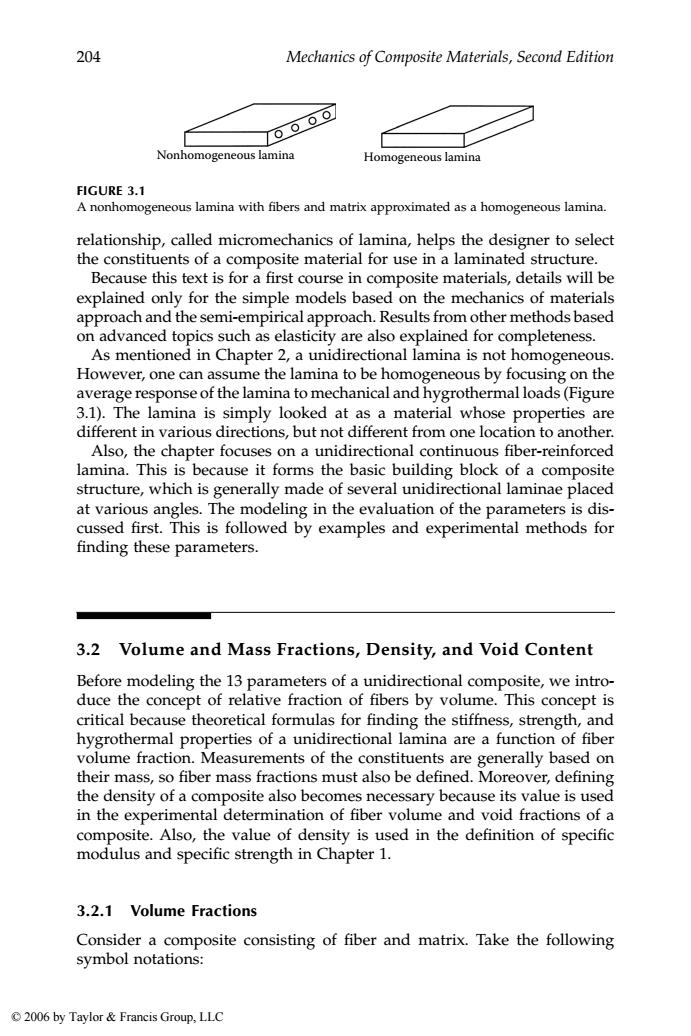正在加载图片...

204 Mechanics of Composite Materials,Second Edition 10000 Nonhomogeneous lamina Homogeneous lamina FIGURE 3.1 A nonhomogeneous lamina with fibers and matrix approximated as a homogeneous lamina. relationship,called micromechanics of lamina,helps the designer to select the constituents of a composite material for use in a laminated structure. Because this text is for a first course in composite materials,details will be explained only for the simple models based on the mechanics of materials approach and the semi-empirical approach.Results from other methods based on advanced topics such as elasticity are also explained for completeness. As mentioned in Chapter 2,a unidirectional lamina is not homogeneous. However,one can assume the lamina to be homogeneous by focusing on the average response of the lamina to mechanical and hygrothermal loads(Figure 3.1).The lamina is simply looked at as a material whose properties are different in various directions,but not different from one location to another. Also,the chapter focuses on a unidirectional continuous fiber-reinforced lamina.This is because it forms the basic building block of a composite structure,which is generally made of several unidirectional laminae placed at various angles.The modeling in the evaluation of the parameters is dis- cussed first.This is followed by examples and experimental methods for finding these parameters. 3.2 Volume and Mass Fractions,Density,and Void Content Before modeling the 13 parameters of a unidirectional composite,we intro- duce the concept of relative fraction of fibers by volume.This concept is critical because theoretical formulas for finding the stiffness,strength,and hygrothermal properties of a unidirectional lamina are a function of fiber volume fraction.Measurements of the constituents are generally based on their mass,so fiber mass fractions must also be defined.Moreover,defining the density of a composite also becomes necessary because its value is used in the experimental determination of fiber volume and void fractions of a composite.Also,the value of density is used in the definition of specific modulus and specific strength in Chapter 1. 3.2.1 Volume Fractions Consider a composite consisting of fiber and matrix.Take the following symbol notations: 2006 by Taylor Francis Group,LLC204 Mechanics of Composite Materials, Second Edition relationship, called micromechanics of lamina, helps the designer to select the constituents of a composite material for use in a laminated structure. Because this text is for a first course in composite materials, details will be explained only for the simple models based on the mechanics of materials approach and the semi-empirical approach. Results from other methods based on advanced topics such as elasticity are also explained for completeness. As mentioned in Chapter 2, a unidirectional lamina is not homogeneous. However, one can assume the lamina to be homogeneous by focusing on the average response of the lamina to mechanical and hygrothermal loads (Figure 3.1). The lamina is simply looked at as a material whose properties are different in various directions, but not different from one location to another. Also, the chapter focuses on a unidirectional continuous fiber-reinforced lamina. This is because it forms the basic building block of a composite structure, which is generally made of several unidirectional laminae placed at various angles. The modeling in the evaluation of the parameters is discussed first. This is followed by examples and experimental methods for finding these parameters. 3.2 Volume and Mass Fractions, Density, and Void Content Before modeling the 13 parameters of a unidirectional composite, we introduce the concept of relative fraction of fibers by volume. This concept is critical because theoretical formulas for finding the stiffness, strength, and hygrothermal properties of a unidirectional lamina are a function of fiber volume fraction. Measurements of the constituents are generally based on their mass, so fiber mass fractions must also be defined. Moreover, defining the density of a composite also becomes necessary because its value is used in the experimental determination of fiber volume and void fractions of a composite. Also, the value of density is used in the definition of specific modulus and specific strength in Chapter 1. 3.2.1 Volume Fractions Consider a composite consisting of fiber and matrix. Take the following symbol notations: FIGURE 3.1 A nonhomogeneous lamina with fibers and matrix approximated as a homogeneous lamina. Nonhomogeneous lamina Homogeneous lamina 1343_book.fm Page 204 Tuesday, September 27, 2005 11:53 AM © 2006 by Taylor & Francis Group, LLC